Images from dive on Nazarene on 1 Sept 2021
Rough sketch of dive site (from DS):
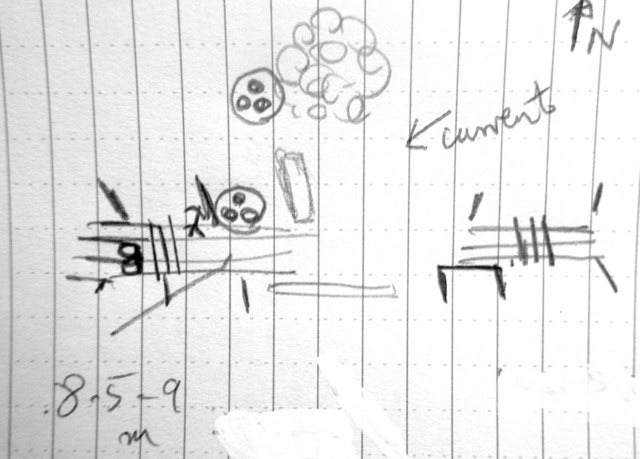
Photos (from PS):
View of wreckage:
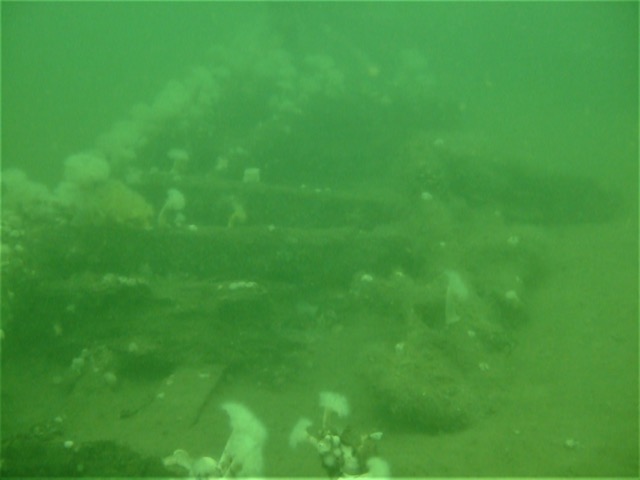
Dead-eye
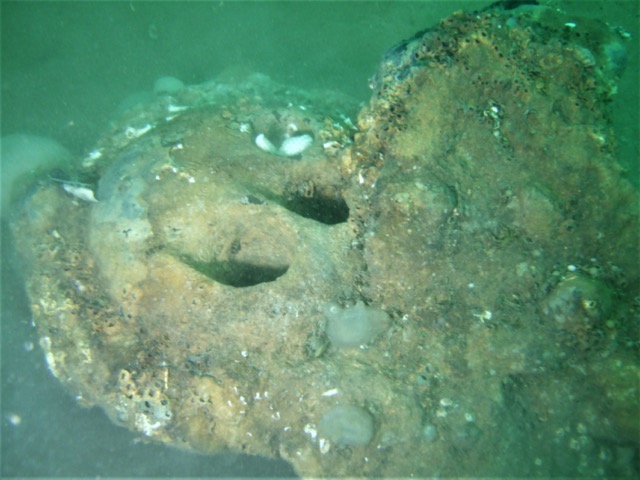
Cables
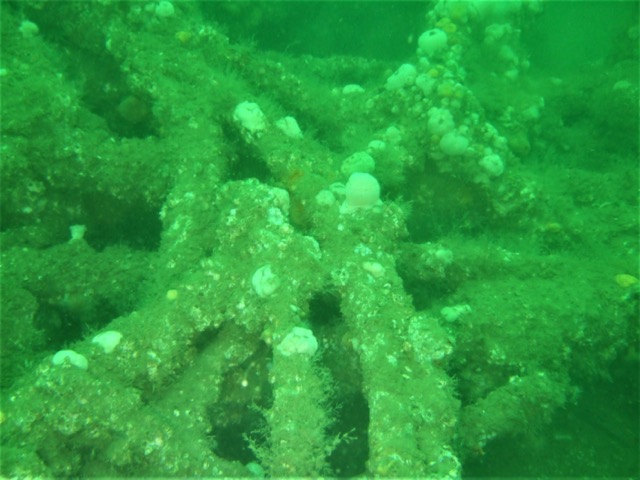
School of small fish:
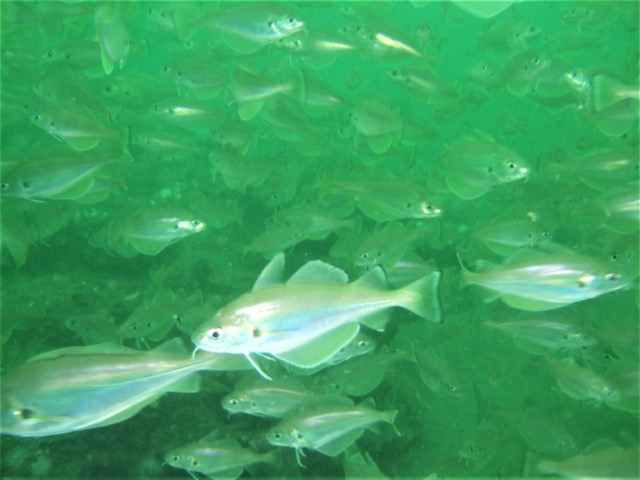
Preston Herald - Wednesday 02 October 1872
WRECK OF A LIVERPOOL SHIP - SUPPOSED LOSS OF THE CREW.
About 5:15 on Saturday night [28 September 1872] signals of
distress
were seen from the Prince's Landing-stage to be hoisted at the Rock
Light. The lifeboat was at once despatched down channel in tow of the
steam tug Tartar. Subsequently, Captain Hill, of the Isle of Man
steamer, Mona's Isle, also reported that he had observed signals of
distress on the Rock Light. Intelligence was likewise received from
the coastguard station at Waterloo that signals of distress were
observed on both the lightships[Crosby and Formby], but that no vessel
in distress could be seen from the station. Captain Evans, of the
steam tug Fiery Cross, shortly afterwards reported having observed,
when crossing the Queen's Channel, a vessel in distress and all sails
flying near Formby. He turned the head of the tug towards the vessel,
but before reaching her, she was driven ashore broadside on the beach.
The sea was making clean over her and he could not approach near
enough to ascertain her name, but saw that she was a large wooden ship
painted black, and of about 1000 tons burden. On his way up the
channel, Captain Evans met the lifeboat and indicated to the crew the
position of the vessel. The lifeboat, however, had to return without
making anything out. The New Brighton Lifeboat, also, went out with a
similar result.
A later account says: there seems to be no doubt that the
vessel
wrecked off Formby was Nazarene, between 800 and 900 tons, which
sailed from Liverpool for Havannah on the 22nd last month [25th in
another account] and, from inquiries we have made, we have been enabled
to learn the following additional particulars of the loss:
About 3:30 pm on Saturday afternoon, Henry Aindow, captain of
the
Formby lifeboat saw a large three-masted vessel about 2 or 3 miles
from the shore heading about SSW as though heading for the Queen's
Channel. As it was nearly dead low water, she could not make that
channel, and at 4.15 she struck on the Northwest point of Mad Wharf,
one of the roughest points on the river. Immediately a signal of
distress was hung out, and Aindow answered it by hanging out a flag
and firing a gun to call together the crew of his boat. In about five
minutes, an answering signal was shown by the Crosby Lightship, and
subsequently by the Rock Lighthouse, from whence information that a
ship was in distress was conveyed to Liverpool. At this time the wind
was blowing a very heavy gale from about W by N, and it was with great
difficulty that the Formby lifeboat could be launched, for it had to
be taken about a mile along the shore to the water's edge in the face
of the wind. About 6:30pm, the boat was got into the water with a crew
on board of 13 men, under the command of Henry Aindow. They had not
proceeded far when a heavy sea broke three of the oars, throwing the
men down, and one of them, Robert Aindow, the mate, fell across the
thwarts with another man on top of him and received rather severe
injuries. The boat was washed ashore and as soon as possible fresh
oars were shipped, together with a man in young Aindow's place. This
boat was again got under weigh, but directly afterwards, four oars
were washed out of the mens' hands, and the boat was driven on shore.
A crowd of people had assembled on shore to witness the attempt to
rescue and render what assistance was possible, and they told Captain
Aindow that it was not worth putting off again, as nothing could be
done. However, a third attempt was made, but equally unsuccessful as
the others. All this time, no one could be seen on the decks of the
ship, even with the aid of a glass, for the sea was dashing over the
vessel about 20 ft above the deck. No lights or rockets were shown,
and even the distress signal was hauled down, or, which is more
probable, blown away, and about 7pm the atmosphere was obscured with
the coming darkness of the night, and with the beating waves, that the
ship could not be seen. A little later, people on shore saw rockets
being fired, apparently from boats in the Crosby Channel, which it is
presumed were the Liverpool and New Brighton lifeboats in tow of
steamers, but as no answer was made, they had to return, not being
able to make out where the distressed vessel was lying. About 9pm, the
lifeboat men left the beach, finding that they could be of no service,
but at 6:30 on Sunday morning they were on the shore again, when
nothing could be seen except 10 or 12 feet of the vessel's forward
bulwarks. The shore, however, in the direction of Ainsdale and
Southport, was strewn with wreckage, consisting of masts, spars,
ship's timbers, portions of boats (on the stern sheets of one of which
was painted "Nazarene Liverpool"), 5 or 6 cwts of ship's bread in a
large iron safe, a barrel of pork, another of brandy, etc., These
things were all gathered up by the coastguardsmen, and deposited on
the shore by the Birkdale lifeboat house, and in the yard of Captain
Reckcliffe, East Bank-street, Southport.
Among other property washed ashore and handed to the police,
were a
number of papers, including bills of exchange on credit drawn in
Havana, Rio de Janiero, Melbourne, and other places, mostly in favour
of Messrs. Loughham & Co.; a quadrant made by Walker of Liverpool, and
a photograph on glass in heavy folding cases of a female with four
children about her. About 4 yesterday morning, the body of an elderly
man, supposed to be that of Captain Brewer, the commander of the
Nazarene, was washed ashore at Ainsdale, with a life-buoy attached,
but not properly fixed. There was a wound on the side of the head as
though the man had been struck struck by a floating spar, and this
probably will account for death in this case. On the body were found
a valuable gold watch, which had stopped at 4:30, and some papers
relating to a ship called the Martha, in which the deceased appeared
to have sailed some years ago. About four hours later, two other
bodies were washed ashore near the same place, one a coloured man and
the other a young nan who had been badly bruised and knocked about.
During the forenoon another body of a young man was recovered from the
sea at Formby, and removed to the dead house near Formby church. A
fifth body was found at two in the afternoon at Ainsdale, having on it
a number of rosaries and scapulars, and, with the others found at the
same place, was removed to the Park Hotel, Birkdale, to await an
inquest.
It is said there are complaints that the Southport lifeboat
did not
put off to the assistance of the ill-fated vessel, but these
complaints are answered by the statement that the Southport station is
about eight or nine miles from Formby, which distance the boat would
have to be drawn by horses in the face of the wind; in addition to
which other lifeboat stations were nearer, so that if help could have
been given, there was plenty of it.
The following is a complete list of the crew and officers of
the ill-fated vessel.
John Brewer master 61 Liverpool
Abraham Green mate 26 Liverpool
Wm Henry Brewer 2nd mate 21 St John NB
Thomas Power carpenter 42 Waterford.
G Anderson steward and cook 30 Jamaica
James John able seaman 26 West Indies
Edward Williams " 21 Boston
Charles Freeman " 21 United States
W Jones " 35 "
Abner Frances " 37 "
Henry Hyde " 27 "
Samuel Reason " 28 "
Isaac Gainiss " 37 "
Geo Norton orderly seaman 20 "
George F Davies " 22 "
W Anderson boy 14 Liverpool
Another man Josh Anderson shipped but did not join the vessel.
The Nazarene which measured 815 tons, was built in Quebec in
1854, and
was owned by Mr W Geves, of Liverpool, late mayor of Bootle. She was a
teetotal ship so that one of the frequent causes of disaster, soon
after leaving port, did not exist in this case. The simple explanation
of the loss appears to be that the vessel suffered damage in the heavy
gale which came on a day or two after she left the Channel, that her
Captain was attempting to put back to port, but on account of a heavy
westerly gale on Saturday, failed to make the channel of the Mersey,
got hopelessly embayed in the shallows off Formby, anchored in the
hope of assistance being sent, but capsized and foundered during
Saturday night, all on board meeting with a watery grave. It is said
that Captain Brewer, who was well known and much respected in shipping
circles at this port, intended to retire from a sea life after this
voyage, having spent nearly all his life of three-score and upwards in
battling with the perils of the ocean. A melancholy circumstance
associated with the wreck is that the boy, Anderson, met with his
untimely death while going out on his first voyage.
Cheshire Observer - Saturday 05 October 1872
WRECK OF THE SHIP NAZARENE OFF LIVERPOOL. LOSS OF ALL HANDS. Another
lamentable shipwreck has occurred near Liverpool, attended by the loss
of all on board. About five o'clock on Saturday evening [28th September] the distress
flag was observed to be hoisted at the Rock lighthouse, at the
entrance to the Mersey, and it was soon known that a large ship was
in a dangerous position in the neighbourhood of Formby. The New
Brighton and Liverpool lifeboats were at once got ready and proceeded
in search of the distressed vessel. They were, however, unable to find
her, and returned to port. The fact of a distressed vessel being
outside was confirmed by the arrival of the Isle of Man steamers,
Snaefell and Mona's Isle, Captains Lewen and Hill both reporting that
when coming in through the Queen's Channel they observed a large ship,
apparently lying at anchor near Formby Point, in a very dangerous
position, and quite out of their reach to render any assistance. The
crew of the steam tug Fiery Cross also observed the same vessel, and
described her as a large vessel of about 1000 tons.
On Sunday morning
one of the Dublin steamers on her passage through the channels also
observed a large ship lying on her beam ends about the spot already
indicated; and on Sunday afternoon a boat having the name "Nazarene,
Liverpool," painted on her stern, was washed ashore at Southport. On
Monday, however, all doubts as to the name of the vessel and the fate
of the crew were cleared up, as at about eight o'clock in the morning
the body of Captain Brewer, of the Nazarene, was washed on to the
Formby beach. The ill-fated vessel left the Mersey on the 22nd
September[actually delayed until 25th] for Havannah, and must therefore have encountered the full
force of the late severe gale. The general opinion is that the
Nazarene was putting back when the disaster occurred, having become
disabled, for repairs, as the vessel when first sighted was evidently
to a certain extent unmanageable.
The Nazarene was a vessel of 815 tons register, built at
Sunderland[sic, Lloyds gives built Quebec] in 1854, and owned in
Liverpool by Mr. W. Geves, but dispatched by Messrs. Thomas King and
Son. When the vessel left the Mersey she had on board a crew of 17
men, under command of Captain J. Brewer. Later accounts state that
dead bodies and wreckage are being washed ashore near the scene of the
catastrophe. The violence of the gale is attested by the condition of
the masts of the wrecked ship. They seem to have been torn out of the
vessel. With regard to the services rendered by the local lifeboats on
this occasion, it seems there is room for inquiry. Mr. Driffield,
county coroner, opened an inquest on Wednesday, on the bodies of the
master and four of the crew. A son of the master (Jacob Brewer)
recognised the bodies of his father and brother. The jury returned a
verdict to the effect that deceased were drowned in the wreck of the
ship Nazarene, but under what circumstances was not shown by the
evidence. We understand the Board of Trade will institute an inquiry
with reference to the loss of the ship.
Shipping and Mercantile Gazette - Thursday 03 October 1872
The Wreck near Southport - Last evening an inquest was held at the Park Hotel,
Birkdale, before Mr. C. E. Driffield, on the remains of the five men,
belonging to the Crew of the Nazarene, who have been washed up on the
shore. John Brewer, a young Seaman, identified two of the bodies as
those of his father, Jacob Brewer, the Master of the Nazarene, and his
brother, William Henry Brewer, the Second Mate, aged 21 years.
Captain Brewer had been on one previous voyage on the foundered
vessel, and witness had heard him say he liked her very well, she was
a snug old ship, with good masts in her. Witness recognised another
of the bodies as that of the Carpenter, Thomas Power, but did not know
the other two men, both of whom were coloured. The Nazarene should
have left the Birkenhead Docks on Sunday week, but did not leave until
the following Tuesday[25th September]. Mary Davis recognised one of the bodies as that
of her husband, George J. Davis, a coloured Seaman, and the other
coloured man she thought was Henry Hyde. Her husband had told her that
if he had seen the ship before, he would not have gone with her, she
seemed so much damaged. Other evidence as to the identification of the
bodies was given by a coloured Seaman named John Singleton, and the
inquest was adjourned to Friday next. Previous to the inquest, a similar
inquiry was held, also before Mr. C. E. Driffield, at Formby, on the
bodies of two of the Crew of the Nazarene. One was that the Cabin Boy,
William Anderson, mulatto, whose father was Cook and Steward on the
ill-fated ship. The other deceased was known as the Big Frenchman, but
none the witnesses knew his name, and, indeed, all the men on board
except the Officers were coloured. An open verdict was
returned.
Shipping and Mercantile Gazette - Friday 04 October 1872
Mersey Docks Board. At the weekly meeting of the Mersey Docks and Harbour
Board, at Liverpool, yesterday, Mr. W. Langton presided. Mr. Job, in
moving the confirmation of the proceedings of the Marine Committee,
said he wished to make a few remarks in reply to several letters which
had appeared in the newspapers in reference to the wreck of the Nazarene. It had
been matter of deep regret, and, he might add, of some little
disappointment, that the Liverpool and Formby lifeboats [New Brighton
lifeboat was maintained by RNLI] did not succeed in
rendering assistance to the Nazarene. The Marine Surveyor had made every
inquiry, and had satisfied himself that the Crews of those boats did all they
could under the circumstances.